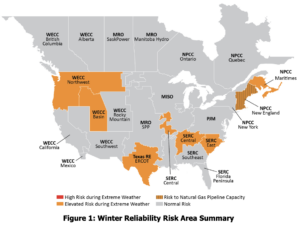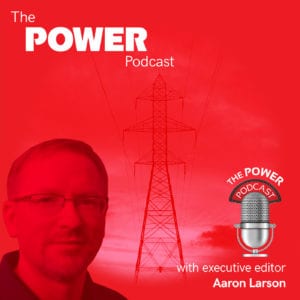demand response
-
Energy Security
NERC: Winter Grid Reliability at Risk Amid Soaring Demand, Fuel Supply Gaps
In its recently released Winter Reliability Assessment, the North American Electric Reliability Corporation (NERC) found that while resources are adequate for normal winter peak demand, large swaths of North America face an elevated risk of electricity shortfalls during prolonged, wide-area cold snaps. Noting that four severe Arctic storms have swept across much of the continent since […]
-
Trends
Extra Effort: Filling the Gaps in Demand Response
The dual challenges of affordability and growing load demand are putting enormous stress on utilities, communities and households. Demand response, a key part of the solution, is falling short, but innovative payment plans can help fill the gap. Residential demand response (DR) is like the aerobic exercise of the electric utility industry. We all know […]
-
Trends
Google, I&M Strike Landmark Deal to Share Clean Capacity and Flex AI Load
American Electric Power (AEP) subsidiary Indiana Michigan Power (I&M) has filed a special customer-specific contract with technology giant Google that could create a dual-purpose arrangement to address power capacity constraints in one of the fastest-growing digital infrastructure regions in the U.S. AEP on Aug. 4 announced that the two companies filed a petition to the […]
-
Markets
PJM’s Record-High Capacity Prices Spark Sector Reckoning as Market Signals, Policy Battles Intensify
Capacity prices in PJM Interconnection’s latest auction spiked to the market’s price ceiling, hitting $329.17/MW-day across the board for the 2026/2027 delivery year—the maximum allowed under new Federal Energy Regulatory Commission (FERC) rules. The regional transmission organization’s (RTO’s) competitive Base Residual Auction (BRA), conducted on July 9, 2025, and released on July 22, secured 134,311 […]
-
T&D
Duke Researchers: Grid Flexibility Key to Accommodate Load Growth
Researchers from Duke University have said that integrating more flexibility into U.S. power grids could help provide the energy needed to power future load growth, particularly the electricity needed to support artificial intelligence and data centers. The group in a Feb. 19 webinar discussed their findings, which are contained in their recent report titled “Rethinking […]
-
Commentary
Five Trends Shaping the Future of Demand Response in 2025
The energy grid is confronting unprecedented challenges, including surging demand, aging infrastructure, and the increasing frequency of extreme weather events. A deep freeze across the East Coast recently generated an all-time winter high demand on the PJM grid, while Texas and Florida dealt with a rare snowstorm. Demand response has emerged as a proven and […]
-
Distributed Energy
Peak Performance: APS’s Virtual Power Plant Saves Big During Brutal Heatwave
Through its innovative virtual power plant (VPP), Arizona Public Service (APS) harnessed smart home devices to save 138 MW during a historic heatwave, shifting peak demand and proving critical for grid
-
Electrification
The Need for Consumer Engagement in the Transition to Clean Energy
To state it simply, current decarbonization goals cannot happen without deeper engagement between utilities and their customers, and utilities are not yet truly harnessing the potential that their customers bring. In order to begin to realize this wholesale shift from customers as “load” to customers as “resource,” utilities must facilitate customer participation in energy-saving initiatives […]
-
Legal & Regulatory
FERC’s Enforcement in Demand Response Case a Lesson for Utilities
For energy consumers that have flexibility to modify their energy use in response to direction from a utility or the relevant transmission operator (i.e., to reduce load by changing or rescheduling what they are doing), selling demand response (DR) can be a lucrative additional revenue stream. Depending on the location, such consumers may have multiple […]
-
Distributed Energy
Driving on Electric Avenue—Innovation Pushes Energy Transformation
A seismic shift is ongoing in the energy space, as transportation, industry, and other sectors turn toward electricity and away from fossil fuels to supply their power. The push for decarbonization of the
-
Distributed Energy
DER Orchestration Helps Utilities with Challenges of Grid, Decarbonization
Renewable energy and distributed energy resources (DERs), including solar and wind, electric vehicles (EVs), battery storage, heat pumps, and new types of controllable load devices, may well prove to be the single most-disruptive influence in the history of the electric grid. Renewables have quickly become the world’s second-largest source of electricity generation, and DERs challenge […]
-
Business
Money Makes the Power and Energy Sectors Go ‘Round
If you’ve seen the musical “Cabaret,” you know that “money makes the world go ‘round” in a variety of ways. While it may not indeed make the power and energy sectors “go ‘round,” money does
-
News
Companies Announce New Residential VPP for California
A distributed energy power plant, designed to help bring more reliability to California’s power grid, is being developed by a company whose investors include Alphabet, the parent company of Google. The project when fully developed would be the world’s largest residential virtual power plant (VPP). Sidewalk Infrastructure Partners (SIP), a group that builds, owns, operates, […]
-
IIOT
National Grid expands DER portfolio with EnergyHub to manage commercial and industrial resources
BROOKLYN, N.Y., 16 September, 2020: National Grid is now managing commercial and industrial (C&I) demand response through EnergyHub’s Mercury DERMS platform, extending a multi-DER portfolio that includes thermostats and residential batteries. With EnergyHub, National Grid can rely on a single platform to manage multiple classes of DERs to provide critical grid services. EnergyHub provides National Grid with enrollment, […]
-
Power Demand
Honeywell to Support Entergy New Orleans’ Commercial Demand Response Goals
Entergy to deploy best-in-class technologies and program management services Large commercial and industrial electricity consumers to receive financial incentives simply by participating in the fully automated demand response program HOUSTON, August 4, 2020 — Honeywell today announced that it will manage Entergy New Orleans’ Large Commercial & Industrial (Large C&I) Demand Response (DR) program. DR provides […]
-
POWER Podcasts
What Is DERMS and How Can It Help Utilities?
A distributed energy resource management system, or DERMS, is a software platform used to manage a group of distributed energy resource (DER) assets—such as rooftop photovoltaic solar panels, behind-the-meter batteries, or a fleet of electric vehicles—to deliver vital grid services and balance demand with supply to help utilities achieve mission-critical outcomes. As a guest on […]
-
Distributed Energy
The POWER Interview: Google, Utilities Partner for Energy Solutions
Businesses are putting more emphasis on sustainability, coordinating their operations to ensure financial success while also being mindful of environmental concerns. Investors in many cases are demanding companies embrace sustainability, which often includes being more efficient in their use of energy. That’s one reason behind the growth in distributed power generation, as companies develop their […]
-
IIOT
Leap, Google Nest Using Automation for Demand Response
Utilities have offered demand response programs for years, in many cases offering rebates or other compensation to customers willing to allow the utility to reduce their household or business power consumption at certain times of the day. Other companies are moving forward with their own programs, seeking a piece of the growing market for automation […]
-
Renewables
AEP, American Power Giant, Sets Goal to Slash Carbon Emissions 80% by 2050
American Electric Power (AEP), one of the nation’s largest power generators, will pursue a strategy to reduce its carbon dioxide (CO2) emissions by 60% from 2000 levels by 2030, and 80% from 2000 levels by 2050. AEP expects to achieve carbon reductions through a variety of actions, including investments in renewable generation and advanced technologies […]
-
Press Releases
SCE Seeks New Distributed Energy Resources in the Goleta Area
Request for Offers issued for resources to bolster local grid resiliency. ROSEMEAD, Calif., March 6, 2017 — Southern California Edison has launched a Request for Offers (RFO) to acquire new distributed energy resources to bolster grid resiliency in the Santa Barbara-Goleta area. The RFO is seeking a range of new distributed energy resources including: energy […]
-
Legal & Regulatory
Regulators’ Meeting Opens with Focus on Infrastructure Conundrum
“We’re at a very challenging time,” said former Federal Energy Regulatory Commission (FERC) Commissioner Tony Clark at the annual meeting of the National Association of Regulatory Utility Commissioners (NARUC) on November 14. We have a “need for infrastructure, but it’s more difficult to get it sited and built than ever before.” Clark’s comment, which he […]
-
Renewables
Electric Co-ops Launch “Community Storage” Initiative
Electric cooperatives are poised to increase their use of electric water heaters as a demand response (DR) and energy storage tool in their service territories.
-
Legal & Regulatory
Supreme Court Revives FERC Order 745 on Demand Response
By a 6–2 vote, the U.S. Supreme Court on January 25 ruled that the Federal Energy Regulatory Commission (FERC) had authority under the Federal Power Act (FPA) to issue rules requiring equal market participation by demand response (DR) resources. FERC Order 745, issued in 2011, required the nation’s Independent System Operators (ISOs) and Regional Transmission […]
-
Legal & Regulatory
FERC Order 745 and the Epic Battle Between Electricity Supply and Demand
From its modest origins as a way to shed load when the grid is stressed, demand response (DR) has grown to be a significant player in electricity markets. In the PJM region, demand response has accounted for as much as 14,833 MW of capacity, almost 10% of the total. Customer Gains and Generator Losses Demand […]




















